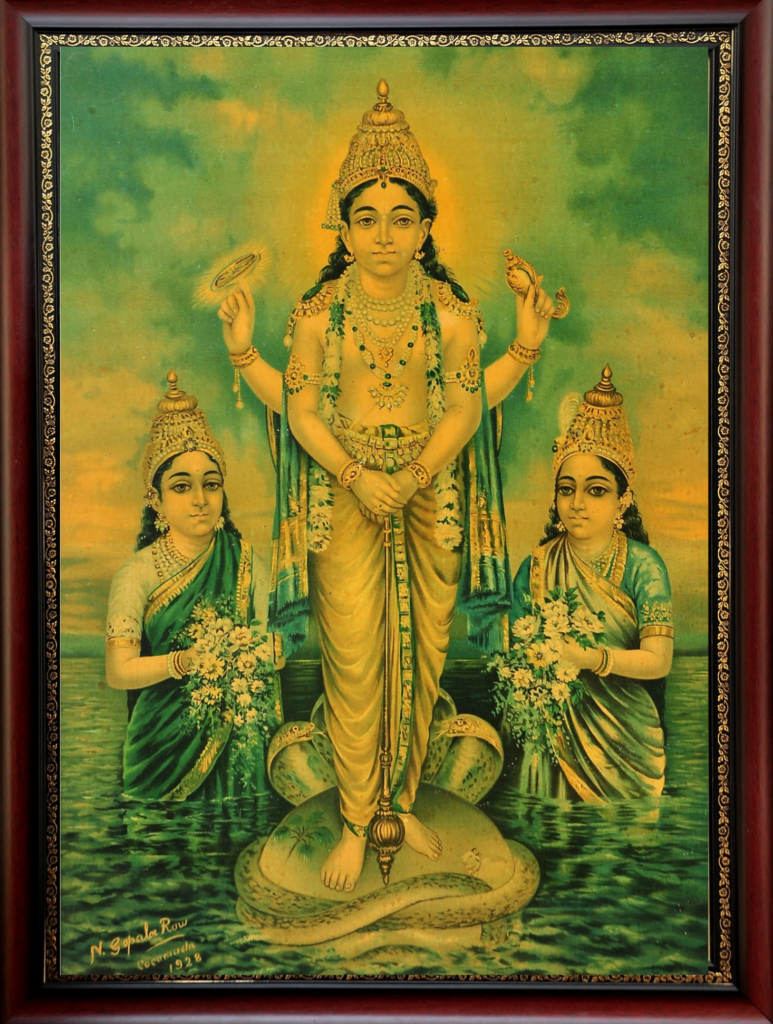Sriman Narayana
Sriman Narayana was his next masterpiece, created in 1928. In this work, the timeless beauty of ancient mythology comes to life through N. Gopala Row’s rich and warm colours. His paintings radiate a divine beauty that invites worship. The vibrant hues in “Sriman Narayana” highlight the artist’s skillfull use of colour. The portrait captures Vishnu’s manifestation as Sriman Narayana, who resides on the milk ocean. He is depicted as the inner essence of all beings, from the tiniest ant to the four-headed Brahma. Vishnu is typically shown holding significant attributes: a conch shell in his upper left hand, symbolizing creativity; a chakra in his upper right hand, representing the mind; a mace signifying individual existence; and a lotus flower, which embodies liberation, this divine figure rests upon the “Kshira Sagar” (ocean of milk). In various scriptures, especially the Puranas, Vishnu is revered as Sriman Narayana
The painting depicts Sriman Narayana adorned with exquisite jewellery and ornaments, featuring a vibrant garland of flowers cascading from his neck. On either side of him stand his two wives, Lakshmi and Padmavathi, each holding flowers. Each of the women showcases unique styles of jewellery, enhancing the overall splendor of the scene.
They emerge gracefully from the ocean, with Sriman Narayana positioned on the tranquil ocean of milk at his feet. To his left, a Tree of Life is beautifully illustrated, while a cow is depicted on his right. the Tree of Life is a powerful representation of growth, fertility, and interconnectedness among all living beings. It signifies the nurturing aspects of the divine, embodying the idea that life is cyclical and that all forms of existence are interrelated. The roots of the tree often symbolize the past and stability, while the branches reaching towards the sky represent aspirations and spiritual growth. In the context of Sriman Narayana, the Tree of Life underscores his role as the sustainer of life and the source of nourishment for all creatures.
The cow holds a particularly revered place in Hindu culture, symbolizing abundance, motherhood, and the spirit of selfless giving. It is seen as a source of sustenance, providing milk and other resources, and represents the nurturing qualities of nature. In many texts, the cow is associated with various deities, and its presence in art often signifies prosperity and blessings.
When depicted alongside Sriman Narayana on the ocean of milk, the Tree of Life and the cow work together to highlight his divine role as a protector and sustainer of all life. The ocean of milk itself symbolizes the primordial ocean from which creation emerged, a cosmic expanse that signifies both potential and transformation. This imagery emphasizes that from this divine source, all forms of life are nourished and sustained, reflecting the harmony between the divine and the natural world. Overall, these elements convey a rich tapestry of meanings related to sustenance, growth, and the interconnectedness of existence, reinforcing Sriman Narayana’s significance in the Hindu faith as a guardian of life and abundance.
The story of Sriman Narayana as Vishnu, who resides on the milk ocean (Ksheer Sagar), is a significant aspect of Hindu cosmology and mythology. It beautifully illustrates the themes of creation, preservation, and the eternal cycle of life.
The Cosmic Context
In Hindu mythology, Vishnu is one of the principal deities, often referred to as the preserver of the universe. He is part of the Trimurti, alongside Brahma the creator and Shiva the destroyer. The narrative often begins with the concept of the cosmic ocean of milk, Ksheer Sagar, which symbolizes the primordial state of existence.
The Churning of the Ocean
The most famous story associated with Vishnu and the milk ocean is the “Samudra Manthan,” or the churning of the ocean. The Devas (gods) and Asuras (demons) sought to obtain the nectar of immortality (amrit). To achieve this, they decided to churn the milk ocean, using Mount Mandara as the churning rod and the serpent Vasuki as the rope.
Vishnu's Role
During this cosmic event, the ocean yielded many treasures, including the goddess Lakshmi, who emerged as the personification of wealth and prosperity. Vishnu, in his divine form, played a crucial role in ensuring that the Devas obtained the nectar. To protect the Devas and maintain cosmic order, he took on the form of a beautiful enchantress (Mohini) to distract the Asuras and ensure the Devas received the amrit.
Vishnu on the Serpent
In some depictions, Vishnu is shown reclining on the serpent Ananta Shesha (or Adishesha), who represents the infinite. This image symbolizes the balance of creation and the infinite nature of the cosmos. Vishnu is often portrayed resting on Shesha, surrounded by the serene waters of the milk ocean, reflecting tranquility and omnipotence.
Conclusion
This rich tapestry of stories emphasizes Vishnu’s role as the protector and preserver, maintaining balance and harmony in the universe. His abode on the milk ocean, coiled by the serpent, serves as a metaphor for stability amidst chaos, illustrating his significance in Hindu spirituality and cosmology.

